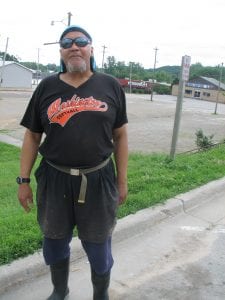
A.T. Docks, a Chicagoan who moved to Columbus Junction, Iowa, to work at Tyson, said the flood was like watching a sci-fi movie in his own backyard.
“It looks like Katrina,” said a man stuck in traffic, his bare foot hanging out his car window, on the jammed freeway through Cedar Rapids on Friday, June 13, as the river swamped the city with 8 feet of water.
And from that vantage point, it did: factories and silos rising out of the flood water like a surreal underwater kingdom; traffic lights and billboards barely above the water level; historic downtown buildings and churches like islands in a deceptively peaceful flow of green water.
But after four days in different Iowa cities covering the floods, I am still struggling with dissonance between the shocking images of cities underwater and, in immediate terms, the lack of human impact — especially in comparison to the floods following Hurricane Katrina.
That’s not to belittle the tens of thousands of people who have suffered immense economic losses and major interruptions in their lives; the impact on jobs, food prices and other effects which will be seen for years to come. But in the immediate sense of life and limb, people have come out okay — only a few deaths have been attributed to flooding across the whole region, and very few injuries.
In Iowa, the hardest-hit state, there are reportedly fewer than 500 people in shelters. Most people are staying with friends or relatives. As a reporter looking for dramatic stories, heart-wrenching tales were surprisingly hard to find. The floods are devastating, but people are pulling together and handling it with characteristic Midwestern cheeriness and stoicism.
This is all an incredibly stark contrast to New Orleans, where the flooding following Hurricane Katrina caused massive loss of life and indescribable human suffering. Though there are many differences in the two situations, one still can’t help but draw comparisons.
Academic and journalistic analyses will doubtless be made at great length in coming months. Without claiming to offer a comprehensive examination, I have some confusing and disturbing thoughts to offer after having reported on both catastrophes.
It is now widely accepted that racism toward and stereotypes about the poor, black population in New Orleans was a major factor in the disastrous, shameful response to the tragedy, from the lack of response from authorities at the outset to the militaristic, violent response later on.
In terms of racial makeup and stereotypical images, Iowa is about as far from New Orleans as you can get — a state with a very small minority population, famous for its wholesomeness and for people generally being “nice.”
From my observations, these positive stereotypes about Iowa were an accurate representation of how everyone dealt with the crisis, from flood victims to National Guardsmen to volunteers. To put it bluntly, law enforcement and volunteers in Iowa were not afraid of or harboring deep-seated hatred toward the people they were trying to help. Unfortunately, that was the case in New Orleans, and part of a vicious cycle where displaced people furious at the treatment they were getting did often lash out violently.
When I asked Iowans, including public officials and flood victims, if they feared looting or violence as happened in the wake of Katrina, numerous people said things along the lines of, “Iowans aren’t like that,” or “that would never happen here.”
I don’t think those people meant any racism or classism by their responses; and they were speaking about their own residents, not those of New Orleans. But by extrapolation, the implications are clear: the residents of New Orleans ARE like that.
Meanwhile, observing the Iowa floods first-hand is further driving home for me the extent of economic devastation and social isolation in poor neighborhoods of New Orleans even before Katrina. While here in Iowa nearly everyone has family or friends to stay with, in New Orleans for many people family and friends were also all in the decimated areas. For the mobile middle and upper classes in America, we forget that following jobs or desires in other cities or even other parts of town is not an option for very low-income people.
And in New Orleans, even if people did have family and friends in other cities or states, they were not physically able to get out of the city for many days, largely because of the governmental failure to act on knowledge of the impending disaster and develop an adequate evacuation plan. In Iowa that has not been a problem. Even though the flooding was much more severe than expected, there was impressive planning and organization on the part of authorities.
Of course in the Midwest, as in Louisiana, low-income people will have the hardest time recovering and rebuilding their lives. The small town of Columbus Junction south of Iowa City is home to workers at the nearby Tyson pork meatpacking plant. Work stopped during the floods, and the workers, many of them immigrants who struggle to send money home, don’t get paid when they don’t work. A.T. Docks, pictured above, a Chicagoan who moved there in February from Chicago to work at Tyson, took it all in stride. He said it was like watching a sci-fi movie in his own backyard.
Even in Cedar Rapids, the socioeconomic factors apparent after Katrina are in play to some degree. Besides downtown commercial and government areas, lower-income neighborhoods in the heart of the city were hardest hit.
In a working-class neighborhood called Czech Village, low-income residents argued with National Guardsmen blocking access to evacuated areas Monday, begging them to let them into their homes to reclaim belongings and pets.
“We heard they’re losing keys and busting windows to get in,” said one woman, on the verge of tears. “If they break the windows and then security leaves, things will get stolen, people will lose everything they’ve worked all their lives for. The poor neighborhoods will be forgotten and left behind, as usual.”
One man pointed out that the homeless used to take refuge in the library, which was decimated by floodwaters. Where will they go now, he wondered.
Outside one of the schools serving as an emergency shelter, an African-American woman evacuated from the downtown domestic-violence shelter cried because she had been kicked out of the temporary shelter for the night after causing a disruption. She didn’t have anywhere else to go.
“I have nothing,” she said. “Not even my daughter’s pictures.”





To even have someone pass opinions about someone or something they have no knowledge of is just stupid!!! “Oh we would never do that” well let me see them sit on their roofs for 3-4 days in 100 degree heat without any water, food or medication and see what happens then. They will do whatever they have to do to survive for them and their families…and if looting is what has to result to then so be it…Instead, “they’ll kill for their kids to be on the soccer team or the cheerleading squad” but I guess that makes perfect sense. There was a plan put into action there….evacuations, shelters ready and everything else necessary that was needed…what happened in New Orleans had no strategic planning and they sure in hell didn’t receive help immediately….as you saw your infamous President flying over the city just looking out of his window..with no regards to life…thousands lost their lives (which was under reported) and still are today due to stress and other aliments…and ya’ll the MEDIA have the audacity to exploit the situation even more so…we’re still struggling trying to get things together with no help from FEMA, BUSH, or anyone else…so please, if you’ve never been in our boat, don’t speculate and sure in the hell don’t point fingers.
Thanks for this post. My heart goes out to the folks there.
Glad the people are getting a response from authorities—that’s as it should be.
And wowser—the stark contrast between the way FEMA jumped up to in this situation versus post-Katrina. Hmm—election year, white voters—a situation the Bushies can easily grasp.
The media depictions difference—also stark. Remember watching the New Orleans coverage and thinking most people were pretty civil considering they were locked up five days in the Superdome before the U.S. government could furnish water. Not to mention the rest of the horror.
The teevee keeps mentioning the agricultural value of the land, the nation’s bread basket blah blah, so that probably factors into the sense of how important the damage is.
BTW an organizer pal of mine was in the 9th ward in New Orleans a few months ago and said you can’t imagine—almost three years later—the blocks and blocks and blocks of devastaion, flattened, blasted neighborhoods. He marveled at the scale.